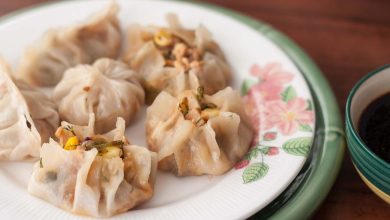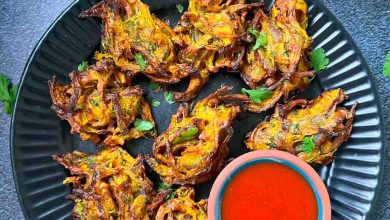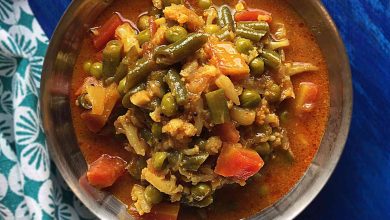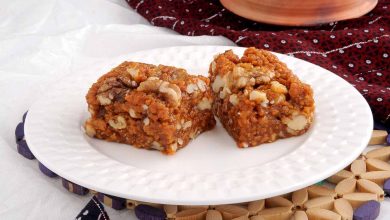In the world of culinary art, few dishes are as enchanting as the bold and aromatic Mustard Vegetable Curry—a recipe that gracefully merges classic Indian spices with a modern twist. This recipe epitomizes the union of tradition and innovation, drawing on the rich history of Indian cuisine while introducing the unexpected tang of Dijon mustard and the creaminess of coconut milk. Over the centuries, spices have served as the heartbeat of Indian cooking, and this curry is no exception. Its layers of flavor—from the sizzling cumin seeds to the mellow sweetness of steamed vegetables—create a symphony that captivates both the palate and the senses. The mustard component offers a unique tang that not only intensifies the overall flavor profile but also adds a subtle pungency, making this dish stand out in a realm filled with well-known curries.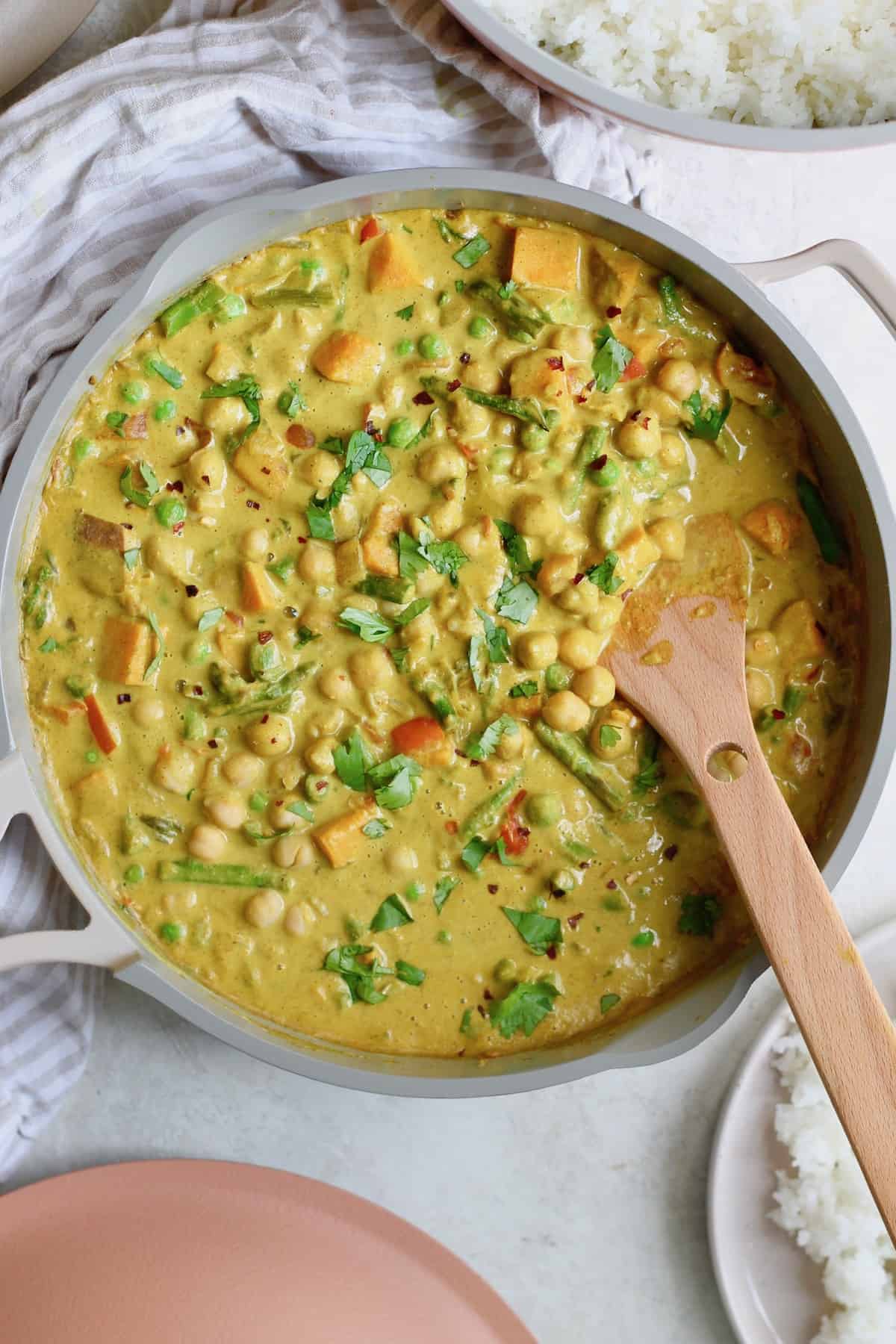
The journey to creating this delectable dish begins with a simple idea: to marry a classic spice blend with unconventional ingredients in order to elevate a regular vegetable curry into something extraordinary. The result is a deeply satisfying curry that can charm a wide range of tastes, from those who appreciate the warmth of traditional Indian spices to the adventurous souls looking for a fresh, tangy twist. In this comprehensive guide, we will delve into every aspect of preparing the Mustard Vegetable Curry—from the time commitment required and the essential kitchen equipment to detailed instructions and insightful tips that ensure a perfect result every time. By the end of this article, not only will you have mastered a timeless recipe, but you will also gain valuable insights into the nuances of Indian cuisine, which have evolved through generations to incorporate both ancient traditions and modern innovations.
As we explore the intricacies of making this curry, you will discover a dish that is versatile, vibrant, and richly layered with aromatic spices and diverse ingredients. This recipe is ideal for vegetarians looking for a hearty, nutritious meal, and it can easily be adapted to suit various dietary preferences. The dish is equally perfect as a main course or a side dish, and its compatibility with common Indian breads, rice, or even tawa paratha makes it a flexible centerpiece for any meal.
In the following sections, we will provide a detailed breakdown of the key components of the Mustard Vegetable Curry, ensuring that every step—whether it’s the preliminary preparation of the ingredients or the final garnishing for presentation—is explained thoroughly. This ensures that even novice cooks can confidently try their hand at this enticing dish while offering experienced chefs innovative ideas to further enhance the flavors and textures. Let us embark on this culinary adventure that celebrates the art of cooking, paying homage to time-honored techniques while exploring new culinary frontiers.
Time
-
Preparation Time: 20 minutes
-
Cooking Time: 30 minutes
-
Total Time: 50 minutes
The overall time required to prepare and cook this dish is relatively moderate, making it a perfect option for busy weeknights as well as leisurely weekend cooking sessions. The initial time investment in chopping, grating, and steaming the vegetables seamlessly blends with the quick sautéing and simmering process, producing a rich, layered flavor profile in under an hour.
Required Equipment
To ensure a smooth and successful cooking experience, gather the following essential kitchen equipment:
-
Large Sauté Pan or Deep Skillet: For sautéing the spices, garlic, and onions.
-
Steamer or Pressure Cooker: For efficiently steaming the carrots, green beans, peas, and potatoes.
-
Mixing Bowls: For prepping ingredients and mixing the curry base.
-
Measuring Cups and Spoons: For accurate measurement of spices, liquids, and other ingredients.
-
Cutting Board and Knives: For chopping and slicing vegetables.
-
Spatula or Wooden Spoon: For stirring the ingredients and ensuring even coating of spices.
-
Lid for Pan: For simmering the curry while retaining moisture and flavors.
-
Serving Bowls and Plates: For the final presentation of the dish.
Tags
-
#MustardVegetableCurry
-
#IndianCuisine
-
#VegetarianRecipes
-
#SpicyCurry
-
#FusionRecipes
-
#HealthyCooking
-
#CoconutMilk
-
#DijonMustard
-
#FlavorfulCurry
These tags not only help in categorizing the recipe but also ensure that culinary enthusiasts searching for innovative twists on traditional dishes can easily find and enjoy this recipe on lovewithrecipes.com.
Serving Size
This recipe serves 4 people.
Designed to cater to a family meal or a small gathering, this dish is ideal for those who appreciate a hearty serving of vegetables imbued with robust flavors. The generous serving size ensures that the meal is filling and satisfying, whether it is served as the main course or as an accompaniment to other dishes.
Difficulty Level
Moderate
While the recipe involves multiple steps—such as steaming the vegetables separately, preparing a layered curry base, and ensuring the perfect balance of spices—it is designed to be accessible to cooks of varying skill levels. The process is straightforward when following the detailed instructions, making it an ideal project for those looking to expand their culinary repertoire with a dish that is both intriguing and rewarding.
Allergen Information
-
Contains:
-
Coconut Milk: May pose issues for those with coconut allergies.
-
Dijon Mustard: Mustard is a known allergen for some individuals.
-
Vegetable Stock: Check ingredients if using commercial stock, as some brands may contain allergens like soy.
-
-
Gluten-Free Option:
Ensure that all complementary ingredients (such as bread or rice served alongside) are certified gluten-free, if required.
This dish is naturally vegetarian and can be easily modified to accommodate various dietary restrictions. Always double-check ingredient labels, especially if cooking for those with severe allergies.
Dietary Preference
-
Vegetarian:
This recipe is 100% vegetarian, making it a delightful option for those who opt to avoid meat. -
Vegan-Friendly:
With minor adjustments (such as ensuring the vegetable stock is vegan and using a plant-based coconut milk), this dish is also suitable for vegans. -
Gluten-Free:
Naturally gluten-free when served with compatible side dishes.
The flexibility of this recipe makes it adaptable for a range of dietary preferences, ensuring that everyone at the table can enjoy the explosion of flavors without compromise.
Course
-
Main Course / Side Dish
The Mustard Vegetable Curry is versatile enough to serve either as a hearty main dish or as a complementary side dish alongside other elements in an Indian-inspired meal. Its robust flavor and texture make it a fine centerpiece for a comprehensive meal experience.
Cuisine
-
Indian Cuisine with a Modern Twist
While rooted in the time-honored traditions of Indian cooking, this recipe embraces a modern approach by incorporating ingredients like Dijon mustard. This innovative adaptation offers a refreshing take on classic Indian flavors, blending tanginess and spice in a harmonious balance.
Ingredients Table
Below is a detailed table listing the necessary ingredients and their corresponding quantities:
| Ingredient | Quantity | Notes |
|---|---|---|
| Oil | 2 teaspoons | Use your preferred cooking oil (e.g., vegetable) |
| Cumin seeds (Jeera) | 1 teaspoon | Enhances the dish with a warm, earthy aroma |
| Garlic (grated) | 2 cloves | Freshly grated for optimal flavor release |
| Onions (finely chopped) | 2 large onions | Creates the flavorful base; finely chopped for even cooking |
| Red Chilli powder | 1 teaspoon | Adjust according to spice tolerance |
| Turmeric powder (Haldi) | ½ teaspoon | Provides a warm color and subtle earthy flavor |
| Coconut milk | 120 ml (about ½ cup) | Opt for full-fat for richness, or low-fat for a lighter version |
| Vegetable stock | 1 cup | Homemade or low-sodium store-bought |
| Dijon Mustard | 2 tablespoons | Adds a tangy twist to the curry base |
| Carrots (Gajjar) | 2 medium carrots, sliced into 1-inch rounds or lengthwise | Steamed to perfection before incorporation |
| Green beans (French Beans) | 5 to 6 beans, cut into 1-inch pieces, steamed | Retain their crunch and color |
| Green peas (Matar) | ¼ cup, steamed | Adds a pop of sweetness and texture |
| Potatoes (Aloo) | 2 medium potatoes, boiled and diced | Ensures a soft, tender contrast with other vegetables |
| Salt | To taste | Enhance overall seasoning, adjust as needed |
Detailed Instructions
1. Preparation of the Vegetables
Before the cooking process begins, it is essential to prepare the vegetables meticulously:
-
Steaming the Vegetables:
Begin by washing all vegetables thoroughly. Peel and slice the carrots into 1-inch rounds or lengthwise slices. Trim the ends of the green beans and cut them into uniform 1-inch pieces. If using fresh green peas, gently steam them along with the other vegetables; if using frozen peas, ensure they are completely thawed before steaming. Potatoes should be boiled until tender, then diced into evenly sized pieces. Steam the carrots, green beans, and peas together using a steamer basket, ensuring minimal nutrient loss. Remember to keep the potatoes separate during steaming if possible, as they require a slightly longer cooking time to reach perfection.
2. Building the Curry Base
With the vegetables prepped and set aside, focus on creating the aromatic foundation of the curry:
-
Heating the Oil and Tempering the Spices:
In a medium-sized pan or deep skillet, heat 2 teaspoons of oil over medium heat. Once the oil shimmers, add 1 teaspoon of cumin seeds (Jeera) and allow them to sizzle. The sizzling process releases the essential oils in the cumin, unlocking its warm and earthy aroma. This is the first step in layering the flavors that will define the dish. -
Adding Garlic and Onions:
Immediately add the grated garlic and finely chopped onions to the pan. Sauté the mixture for several minutes, stirring intermittently to avoid any sticking or burning. The onions will gradually transform from a translucent white to a delicate light pink hue, signaling that they are soft and aromatic. This caramelization process is critical, as it builds the backbone of the curry’s flavor.
3. Incorporating the Spices
Once the base is aromatic and the onions have softened adequately, it is time to introduce the spice elements:
-
Mixing in Red Chilli Powder and Turmeric:
Sprinkle 1 teaspoon of red chilli powder and ½ teaspoon of turmeric powder (Haldi) into the pan. Stir the mixture immediately to ensure that the spices evenly coat the onions and garlic. This step intensifies the flavor and color of the curry, creating a tantalizing aroma that hints at the dish’s complex taste profile. The spices meld with the oil, forming a fragrant paste that will be the heart of the curry.
4. Adding the Liquid Components
The next crucial step in forming the curry base involves incorporating the liquids that give the dish its creamy consistency:
-
Combining Coconut Milk, Vegetable Stock, and Dijon Mustard:
Pour in 120 ml of coconut milk and 1 cup of vegetable stock into the pan. Stir well to blend the liquids with the spiced mixture, ensuring a smooth consistency. Gradually introduce 2 tablespoons of Dijon mustard into the mix, stirring continuously until fully combined. The mustard not only infuses a gentle tanginess but also enhances the complexity of the curry. Season with a pinch of salt and taste the mixture, adjusting the seasoning as needed.
5. Integrating the Steamed Vegetables
At this stage, the curry base is bubbling with a harmonious blend of spices and creamy liquids. Now, it is time to incorporate the steamed vegetables:
-
Gently Mixing in the Vegetables:
Add the steamed carrots, green beans, peas, and the diced boiled potatoes to the curry base. Stir gently to coat each piece of vegetable evenly with the aromatic sauce. Care must be taken during this process to ensure that the textures of the vegetables remain intact and that they absorb the flavors without becoming overly mushy.
6. Simmering the Curry
The final stage of the cooking process involves a brief simmer to allow the vegetables to absorb the rich, spiced sauce fully:
-
Allowing Time for Flavor Infusion:
Reduce the heat to low, cover the pan with a lid, and let the curry simmer for 3 to 4 minutes. This step allows the flavors to meld and the vegetables to soak in the tangy and aromatic sauce. The result is a dish where every bite bursts with intricate layers of flavor, a true testament to the art of slow, mindful cooking.
7. Serving Suggestions
-
Final Presentation:
Once the mustard vegetable curry has simmered to perfection, remove it from the heat. The dish is best served immediately while it is warm, paired with steamed rice, crusty bread, or traditional Indian tawa paratha. The aromatic blend of spices and the subtle tang from the mustard create a perfect harmony that appeals to both the eyes and the palate.
Preparation Tips
To guarantee an optimal cooking experience and elevate the final outcome of your Mustard Vegetable Curry, consider the following tips:
-
Uniformity in Vegetable Cutting:
To ensure even cooking, cut all vegetables into similar-sized pieces. This avoids situations where some vegetables become overcooked while others remain underdone. -
Attention to Sautéing:
Patience is key while sautéing the garlic and onions; allow them to slowly release their sweetness and aroma. Rushing this process might result in a less vibrant flavor profile. -
Balance the Spices:
Taste as you go. Adjust the quantity of red chilli powder and salt according to your preference. The curry’s beauty lies in its adaptability, meaning that you can tweak the spice levels without compromising the overall integrity of the dish. -
Steaming vs. Boiling:
Steaming helps in preserving the natural colors and nutrients of the vegetables better than boiling. If you choose to boil, do so minimally and in a controlled manner. -
Mustard Integration:
When adding Dijon mustard, stir continuously to evenly distribute its tangy flavor throughout the sauce. This ensures that no single bite is overwhelmingly potent. -
Simmering Time:
Avoid prolonged simmering after adding the vegetables, as this may lead to an overcooked texture. The goal is to allow the vegetables to harmonize with the sauce while retaining their inherent crunch and brightness.
Nutritional Information Table
Below is a comprehensive breakdown of the approximate nutritional values per serving of the Mustard Vegetable Curry:
| Nutrient | Approximate Value (Per Serving) |
|---|---|
| Calories | ~200 kcal |
| Protein | ~3 g |
| Carbohydrates | ~35 g |
| Dietary Fiber | ~6 g |
| Sugars | ~7 g |
| Fat | ~8 g |
| Saturated Fat | ~4 g |
| Sodium | ~400 mg |
Note: These nutritional values are approximate and may vary depending on the specific brands and measurements used. For more precise calculations, consider using a nutritional calculator based on your ingredients.
Tips and Tricks
To further refine your Mustard Vegetable Curry and ensure it stands out in both flavor and presentation, try the following:
-
Experiment with Additional Spices:
While the classic spice mix is integral to the recipe’s appeal, consider experimenting by adding a dash of garam masala or curry leaves towards the end of cooking. This can introduce new layers of aroma without overwhelming the dish’s fundamental flavor. -
Enhance the Mustard Flavor:
If you enjoy a pronounced mustard profile, lightly toast whole mustard seeds in oil at the very beginning, or stir in an extra teaspoon of Dijon mustard towards the end of the preparation. Be cautious, as too much mustard can overpower the delicate balance of spices. -
Vegetable Variations:
The versatility of this curry allows for the inclusion of additional vegetables such as cauliflower, zucchini, or even diced bell peppers. Ensure that any extra vegetables are pre-cooked appropriately to maintain harmony in texture and flavor. -
Consistency Adjustments:
Depending on your preference, adjust the thickness of the sauce by varying the quantity of coconut milk or vegetable stock. For a richer sauce, opt for full-fat coconut milk; for a lighter option, reduce the amount slightly or substitute with almond milk. -
Layering Flavors:
Consider adding a squeeze of lime juice or a sprinkling of fresh chopped cilantro right before serving. These final touches can add a bright, fresh contrast to the warm, spiced sauce.
Add-ons
To further enrich your culinary experience, consider these add-ons that can elevate the dish to new heights:
-
Protein Boost:
Add a plant-based protein such as paneer cubes (for lacto-vegetarians) or tofu (for vegans) towards the end of cooking. Lightly pan-fry the protein until golden and incorporate it into the curry for an added textural contrast and nutritional boost. -
Leafy Greens:
Toss in a handful of spinach or kale during the last minute of simmering for extra nutrients and a vibrant color contrast in the dish. -
Nuts and Seeds:
Garnish with a sprinkling of toasted sesame seeds or chopped cashews. These add a pleasant crunch and enhance the overall flavor profile of the curry. -
Herbal Enhancements:
Fresh herbs such as mint or basil can be used as a garnish to lend an aromatic freshness. Their subtle flavors balance the tang and spice of the curry exquisitely.
Side Dishes
Pairing your Mustard Vegetable Curry with complementary sides can transform the meal into an elaborate feast. Here are some suggestions:
-
Steamed Rice:
The most classic pairing, steamed basmati rice offers a neutral canvas that allows the vibrant curry to shine. -
Crusty Bread:
Serve with artisan bread, such as sourdough or a lightly toasted flatbread, to help scoop up the rich sauce. -
Tawa Paratha or Naan:
Traditional Indian breads like tawa paratha or naan bring an authentic touch to the dining experience. Their soft, chewy texture pairs beautifully with the smooth, creamy curry. -
Salad:
A crisp, lightly dressed salad featuring cucumbers, tomatoes, and red onions can offer a refreshing counterpoint to the hearty flavors of the curry. -
Raita:
A cooling cucumber or mint raita made with yogurt not only balances the spices but also introduces an appealing texture and flavor contrast.
Improvements
For culinary enthusiasts looking to push the boundaries of the traditional Mustard Vegetable Curry, here are some improvement ideas to consider:
-
Enhanced Spice Blends:
Customize your curry by adding spices such as fennel seeds, cardamom pods, or bay leaves during the initial tempering process. Experimenting with spice ratios can yield a unique flavor profile that reflects your personal taste. -
Smoked Flavor:
Introduce a hint of smokiness by lightly charring some of the vegetables on an open flame or by using a smoked paprika variation. This technique can add depth and an intriguing twist to the dish. -
Fusion Elements:
For an adventurous culinary twist, incorporate a splash of tamarind paste or even a hint of maple syrup to subtly alter the balance between sour and sweet, creating a multidimensional flavor experience. -
Textural Enhancements:
Consider lightly frying the diced potatoes after boiling to add a crispy texture before incorporating them into the curry, thereby contrasting the otherwise soft vegetables. -
Presentation Refinements:
Garnish with microgreens, finely chopped cilantro, or even edible flowers for an eye-catching presentation that enhances the overall dining experience—especially for special occasions or when entertaining guests.
Storage and Preservation
Proper storage techniques help maintain the dish’s flavors and textures for later enjoyment:
-
Refrigeration:
Allow the curry to cool completely at room temperature before transferring it into an airtight container. Store in the refrigerator for up to 3 days. Reheat gently on the stovetop over low heat, stirring occasionally to regain the original consistency. -
Freezing:
For longer storage, consider freezing the curry. Transfer the cooled curry into freezer-safe containers or zipper-lock bags, leaving some space at the top to account for expansion. The curry can be safely frozen for up to 2 months. Thaw overnight in the refrigerator and heat thoroughly before serving. -
Labeling:
Always label your storage containers with the date and contents for easy identification and to track freshness.
Frequently Asked Questions (FAQ)
Q1: Can I use a different type of mustard in this recipe?
A:
Absolutely. While Dijon mustard is used in this recipe for its unique tang and smooth consistency, you can substitute it with whole-grain mustard or even a homemade mustard paste for a slightly varied texture and flavor.
Q2: What alternatives can I use if I don’t have coconut milk?
A:
If coconut milk is unavailable or if you prefer a lighter variation, you may substitute with almond milk or cashew milk. Bear in mind that these alternatives might slightly alter the richness of the curry, so consider adjusting the seasoning accordingly.
Q3: How can I adjust the recipe for extra spice?
A:
Increase the quantity of red chilli powder gradually to suit your heat tolerance, or add finely chopped green chilies during the sautéing process. An added pinch of garam masala near the end of cooking can also enhance the warmth and spiciness of the dish.
Q4: Is it necessary to steam the vegetables, or can I sauté them directly in the curry?
A:
Steaming the vegetables beforehand helps maintain their structure, vibrant colors, and nutrients. However, you can sauté them directly in the curry if you prefer a softer texture, though you may need to adjust the cooking time to ensure even doneness.
Q5: What can I do if my curry turns out too thick or too thin?
A:
If the curry is too thick, gradually add a bit more vegetable stock or water to loosen it without diluting the flavors excessively. Conversely, if it’s too thin, allow the curry to simmer uncovered for a few extra minutes until it reaches your desired consistency.
Q6: Can I make this dish in advance?
A:
Yes, the Mustard Vegetable Curry tastes even better the next day once the flavors have had time to meld. Store it in an airtight container, and reheat gently on the stovetop. Just be sure not to overheat to avoid losing the creamy texture of the coconut milk.
Q7: What are some creative ways to repurpose leftovers?
A:
Leftover curry can be used as a filling for wraps, added to grain bowls, or transformed into a delicious baked casserole by mixing it with additional vegetables and a topping of breadcrumbs or cheese (if dietary restrictions allow). It can also serve as a base for fusion recipes like a spiced vegetable pie or stuffed parathas.
Conclusion
The Mustard Vegetable Curry is more than just a dish; it is a culinary journey that connects traditional Indian cooking with modern innovative twists. From its aromatic beginnings with sizzling cumin and garlic to its vibrant medley of steamed vegetables enveloped in a smooth, tangy sauce, every step in the recipe is a tribute to the art of balancing flavors and textures. With its moderate preparation time and adaptability for various dietary needs, this curry is an ideal choice for both weeknight meals and festive gatherings.
Every element—from the choice of spices to the creative use of Dijon mustard—has been meticulously curated to produce a dish that is not only visually appealing but also nutritionally beneficial. The harmonious blend of ingredients ensures that every serving bursts with layers of nuanced flavor while remaining accessible to cooks of all skill levels.
This recipe is a celebration of culinary diversity, inviting you to explore new flavor territories while remaining rooted in the traditions of Indian cuisine. The Mustard Vegetable Curry offers the perfect balance of health, taste, and versatility, making it a must-try for anyone looking to infuse their menu with a fresh and exciting twist on a classic recipe.
Whether served alongside steamed basmati rice, freshly baked naan, or a crisp salad, this dish promises an unforgettable dining experience that delights the senses and nourishes the body. Embrace the opportunity to innovate in your kitchen, adjust flavors to your liking, and most importantly, savor every bite of this richly crafted curry.
References
-
Indian Spices and Culinary Techniques:
-
The Complete Book of Spices and Seasonings – A comprehensive guide to understanding the spice trade in Indian cooking.
-
Indian Cooking Unfolded by Raghavan Iyer – An insightful exploration of traditional Indian recipes and techniques.
-
-
Culinary Fusion Concepts:
-
Flavorful Fusion: Modern Twists on Classic Dishes – A resource on innovating traditional dishes with contemporary ingredients.
-
Online articles and culinary blogs from reputed platforms like Serious Eats, BBC Good Food, and Food52 have inspired several fusion recipes incorporating unique ingredients such as Dijon mustard in traditional curries.
-
-
Nutritional Analysis:
-
The Nutrition Source – Harvard T.H. Chan School of Public Health’s resource on nutritional science and culinary health.
-
USDA FoodData Central – For accurate nutrient profiling of common ingredients.
-
An Extended Perspective on the Mustard Vegetable Curry
The Cultural Intersection of Flavors
The world of cuisine is full of stories waiting to be told—stories of historical trade routes, ancient culinary secrets, and the innovative spirit of home cooks who dared to experiment. The Mustard Vegetable Curry is one such story, weaving together the traditions of Indian cooking with contemporary culinary innovation. In Indian cuisine, mustard—whether in the form of seeds or as a prepared condiment—has been valued for its intensity and versatility. Its incorporation in this curry is a nod to the ancient use of mustard in various regional dishes, yet its modern rendition with Dijon mustard brings forth a fresh narrative that is accessible to a global audience.
In a broader context, the integration of ingredients across culinary borders is a testament to the ever-evolving nature of food. Historical influences and migration patterns have continuously enriched local cuisines, resulting in recipes that are both traditional and experimental. The tangy, slightly pungent mustard complements the earthy notes of cumin and turmeric, while the luxurious coconut milk provides a counterbalance—resulting in an ensemble that is as harmonious as it is unexpected.
A Journey Through Time and Taste
Embarking on the creation of this dish, one can almost trace the evolution of spice usage in Indian kitchens—from the ancient Ayurvedic practices to the vibrant street food culture found in modern urban centers. Each ingredient in the Mustard Vegetable Curry carries its own history:
-
Cumin Seeds: One of the oldest spices used in Indian cooking, celebrated for its digestive properties and robust aroma.
-
Turmeric: Revered not just for its color but also for its anti-inflammatory properties, turmeric is an emblem of Indian culinary heritage.
-
Coconut Milk: Widely used in the southern regions of India, coconut milk introduces a rich creaminess that balances the spices beautifully.
-
Dijon Mustard: A surprising yet brilliant addition, its origins in French cuisine and its modern usage in global kitchens reflect the transformative power of culinary fusion.
The meticulous process of preparing the vegetables—steaming them to perfection before integrating them into the curry—ensures that the texture and nutritional integrity of each component is preserved. The layering of flavors through successive stages of cooking is a celebration of the intricate dance of heat, spice, and time. It is this multi-step process that makes the Mustard Vegetable Curry not just a dish, but an experience—a journey that transforms simple ingredients into a masterpiece of taste and aroma.
Emphasizing the Importance of Technique and Patience
One of the most critical factors in achieving culinary excellence is the technique. A dish as layered as the Mustard Vegetable Curry requires deliberate attention at every stage of preparation. For instance, allowing the cumin seeds to release their essential oils in a preheated oil ensures that the subsequent ingredients are touched by a subtle warmth from the very start. Similarly, slow-cooking the onions until they achieve a translucent light pink is not merely a step—it is a carefully orchestrated moment where the foundation of flavor is established.
Patience, in this regard, is not just a virtue—it is a necessity. The gradual integration of spices, the careful blending of mustard with coconut milk, and finally, the gentle simmering with steamed vegetables ensure that every component interacts harmoniously. This measured approach is what elevates a simple curry into an exceptional culinary creation.
The Art of Balancing Health and Flavor
In today’s fast-paced world, healthy eating has become more than just a trend—it is an essential aspect of our lifestyle. The Mustard Vegetable Curry is a prime example of how healthful ingredients can be combined to produce a dish that is both nutritious and indulgent. Rich in vitamins, minerals, and antioxidants, the vegetables contribute to a robust nutritional profile. Meanwhile, the balanced use of coconut milk and a careful selection of spices not only enhances the flavor but also offers numerous health benefits, from improved digestion to anti-inflammatory properties.
For those conscious of their dietary preferences, this dish can be easily adapted to be vegan, gluten-free, or even low-fat without sacrificing its signature taste. Every ingredient is chosen not only for its flavor but also for its ability to contribute positively to the overall nutritional value of the meal.
Embracing the Modern Kitchen: Innovation Meets Tradition
The modern kitchen is a space where tradition meets innovation, and the Mustard Vegetable Curry is a testament to this evolving narrative. By introducing an ingredient like Dijon mustard—a product that might seem out of place in traditional Indian cooking—the recipe underscores the willingness to explore new boundaries. This innovative approach is especially appealing to modern food enthusiasts who crave familiar tastes enriched with a dash of novelty.
Moreover, the adaptability of the recipe means it can easily become a canvas for further experimentation. Whether incorporating additional vegetables, tweaking spice blends, or even experimenting with different types of oils and stocks, each variation provides an opportunity to create a version of the dish that is uniquely yours.
Detailed Culinary Insights: Step-by-Step Exploration
Let us now delve deeper into each phase of the cooking process, expanding upon the initial instructions to provide a granular view of the art and science behind the Mustard Vegetable Curry.
Step 1: Vegetable Preparation
The cornerstone of this dish is the careful preparation of each vegetable. A successful curry requires vegetables that not only cook evenly but also retain a distinct texture that contributes to the overall mouthfeel of the dish. Start with the freshest produce available and consider organic options for enhanced flavor and nutritional content. Washing the vegetables thoroughly, peeling when necessary, and cutting them uniformly ensures that they cook at the same rate—a critical factor that prevents the overcooking of some components while others remain underdone.
Steaming is the preferred method of cooking here as it preserves both color and nutrients. The gentle heat allows the vegetables to retain their natural flavor and vibrancy, which is crucial when they are later bathed in the richly spiced sauce.
Step 2: Crafting the Curry Base
The foundation of any good curry lies in its base, and here, the method of tempering the spices is of paramount importance. Heating the oil to the right temperature is the first challenge. Too little heat might leave the spices underdeveloped, while too much can cause them to burn, resulting in a bitter taste. Once the oil is properly heated, add the cumin seeds and allow them a brief moment to burst open—releasing their oil and aroma. This moment, though fleeting, sets the stage for a cascade of flavors that follow.
As garlic and onions are added, the cooking process becomes an art of transformation. The slow caramelization process that the onions undergo not only softens their texture but also releases natural sugars, giving the curry a subtle sweetness that counterbalances the tang and heat.
Step 3: Integration of Spices and Liquid Ingredients
Once the aromatic base has been established, it is time to introduce the spices and liquid ingredients that will bind the dish together. The red chilli powder and turmeric are not added merely for their flavor, but also for their color—each contributing to the visual appeal of the finished dish. The vibrant red and yellow hues lend an inviting appearance, setting expectations for the sensory experience that is to follow.
The introduction of coconut milk and vegetable stock creates a luscious, smooth texture that is integral to the dish’s appeal. The coconut milk, in particular, plays a dual role: it contributes both creaminess and a subtle sweetness, helping to mellow out the intensity of the spices. The Dijon mustard, with its sharp tang, provides a contrast that awakens the palate and binds the flavors in a harmonious dance.
Step 4: The Final Assembly
Integrating the previously steamed vegetables into the curry base is a delicate operation that requires both precision and care. The goal is to coat the vegetables evenly in the fragrant sauce without compromising their inherent texture. A light yet thorough stirring technique ensures that each piece of vegetable is imbued with the tangy, spiced gravy.
Simmering the dish for a brief period allows the vegetables to absorb the flavors while ensuring that the sauce thickens slightly—creating a consistency that is both hearty and indulgent. This final step is where all the individual components come together, resulting in a unified dish that is complex in flavor yet simple in its execution.
Step 5: The Final Touches
The last moments before serving involve thoughtful garnishing and a final round of seasoning adjustments. A squeeze of lime juice or a sprinkling of fresh herbs such as cilantro can elevate the dish, providing a burst of freshness that contrasts beautifully with the warm spices. These finishing touches are essential in rounding out the flavor profile, ensuring that every bite is balanced and full of depth.
The Broader Impact of Culinary Innovation
Rediscovering Traditional Ingredients
The incorporation of mustard into a traditional Indian curry is an example of how chefs and home cooks alike are reimagining classic dishes. Traditional Indian cuisine is rich with history and flavor, yet it is also continually evolving as new ingredients are discovered and integrated. This process of culinary experimentation keeps the cuisine vibrant and relevant in a globalized food culture.
Mustard, with its historical use in various regional recipes, finds new life in this dish as it interacts with other well-known ingredients. This melding of old and new does more than just create a unique flavor—it highlights the importance of creativity in the kitchen, encouraging both seasoned cooks and beginners to venture outside their comfort zones.
Enhancing Nutritional Value
Nutrition is a cornerstone of modern cooking, and recipes like the Mustard Vegetable Curry offer a myriad of health benefits. Rich in vitamins, antioxidants, and essential minerals, the vegetables form a nutrient-dense foundation, while spices such as turmeric and cumin not only enhance flavor but also support digestion and overall health. The integration of coconut milk adds a source of healthy fats, contributing to satiety and providing essential energy. This dish, therefore, is not just about taste—it is about nourishing the body and mind with every bite.
A Culinary Canvas for Personal Expression
One of the most exciting aspects of preparing a dish like this curry is the freedom it offers to experiment and express personal culinary style. Whether adjusting spice levels, introducing new vegetables, or playing with garnishing options, every variation is an opportunity to make the dish truly your own. In today’s culinary landscape, recipes are rarely static; they are starting points for innovation, inviting cooks to explore, adapt, and create based on their own taste preferences and cultural influences.
Final Thoughts
The Mustard Vegetable Curry is a testament to the power of culinary fusion. By combining traditional Indian spices with modern ingredients like Dijon mustard, it transcends conventional boundaries to create a dish that is both familiar and refreshingly innovative. Every component, from the initial tempering of cumin seeds to the final garnish of fresh herbs, is a delicate note in a complex symphony of flavors that is as satisfying to prepare as it is to eat.
This recipe not only serves as a delicious meal but also as an inspiration for those who wish to explore new culinary horizons. Its adaptability to various dietary needs and occasions—from simple weekday dinners to elaborate festive gatherings—cements its place as a modern classic that honors the traditions of Indian cuisine while boldly stepping into the future of cooking.
Enjoy the process, savor the flavors, and let the creativity of your kitchen shine through. The Mustard Vegetable Curry is more than a recipe; it is an experience, a journey that invites you to celebrate the art of cooking with every aromatic, sumptuous bite.
References and Additional Resources
-
Books and Publications:
-
The Complete Book of Spices and Seasonings – For an in-depth understanding of the aromatic properties of spices.
-
Indian Cooking Unfolded by Raghavan Iyer – An exploration of traditional methods and modern adaptations in Indian cuisine.
-
Flavorful Fusion: Modern Twists on Classic Dishes – A resource that highlights innovative approaches to combining traditional and contemporary ingredients.
-
-
Online Culinary Platforms:
-
Serious Eats: Insightful articles on the science of cooking and innovative recipes.
-
BBC Good Food: A comprehensive archive of recipes and nutritional guides.
-
Food52: A platform celebrating creative home cooking and fusion recipes.
-
-
Nutritional Information:
-
USDA FoodData Central – For detailed nutrient breakdowns of individual ingredients.
-
Harvard T.H. Chan School of Public Health – For insights on the benefits of spices and whole foods in a balanced diet.
-
-
Culinary Techniques:
-
Video tutorials and step-by-step guides on YouTube channels dedicated to Indian cuisine and fusion cooking methods.
-
Embracing the Journey
Each time you step into the kitchen to prepare this Mustard Vegetable Curry, remember that you are not simply following a recipe—you are embarking on a journey of culinary discovery. With every slice of vegetable, every sprinkle of spice, and every simmering moment, you are part of an age-old tradition that honors the flavors of the past while boldly embracing the potential of modern innovation. Whether you choose to serve it as a stand-alone meal or pair it with an array of delectable side dishes, the dish promises a comforting, nourishing, and inspiring experience that resonates well beyond the boundaries of ordinary cooking.
The intricate blend of mustard, coconut milk, and the classic spices creates a narrative that is both timeless and remarkably contemporary, inviting you to experiment, taste, and appreciate the subtle interplay of flavors that transform a simple vegetable dish into an extraordinary culinary masterpiece. This dish is a celebration of diversity—in ingredients, in cooking techniques, and in the myriad of ways food can bring people together around the table.
As you explore the vast landscape of flavors that this curry offers, allow yourself the freedom to innovate and personalize each step. Your kitchen is your laboratory, and every ingredient is a brushstroke on the canvas of your culinary creation. Enjoy the creativity, cherish the process, and savor the delicious, transformative experience that is the Mustard Vegetable Curry.
Conclusion
In conclusion, the Mustard Vegetable Curry is a remarkable blend of tradition and innovation—a dish that honors the classic techniques of Indian cooking while boldly incorporating modern elements that elevate its flavors and textures. With its moderate preparation time, adaptable ingredients, and impressive nutritional benefits, this curry is well-suited for anyone seeking a fulfilling, healthy, and delectable meal. The detailed instructions, comprehensive tips, and extensive insights provided in this article equip both novice and experienced cooks with the knowledge necessary to master the dish, ensuring that every attempt results in a culinary triumph.
Whether served on a quiet evening at home or as the centerpiece of a festive gathering, this dish invites you to explore the depths of flavor, celebrate the art of cooking, and embrace the innovative spirit that drives culinary evolution. Enjoy every step of the process—from the sizzling of cumin seeds to the final garnish of vibrant herbs—and let the Mustard Vegetable Curry transform your dining experience into a celebration of taste, tradition, and creativity.
May this dish serve as a source of inspiration, a catalyst for culinary innovation, and a reminder of the endless possibilities that arise when diverse flavors converge in a harmonious blend. Happy cooking and bon appétit!



